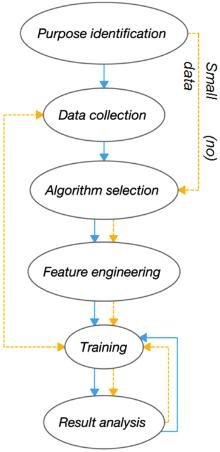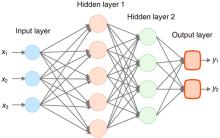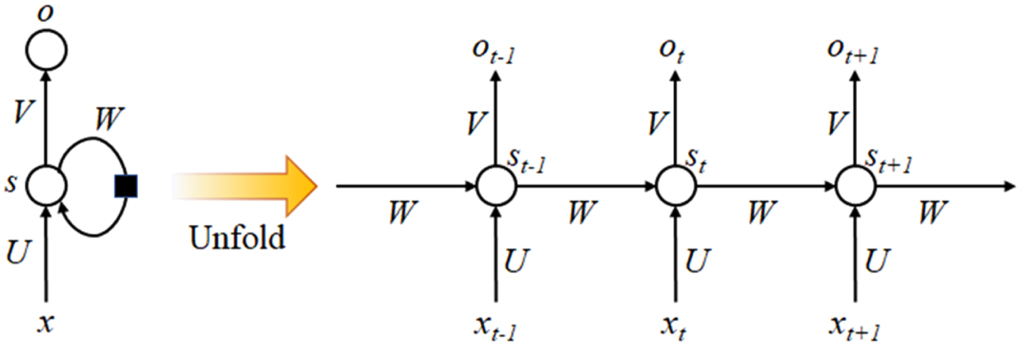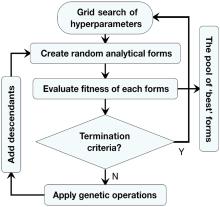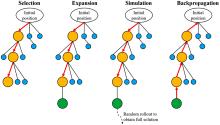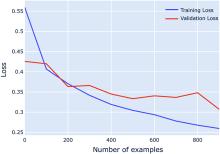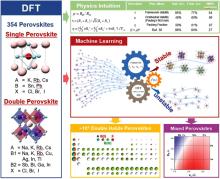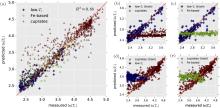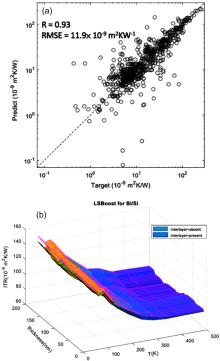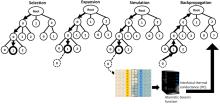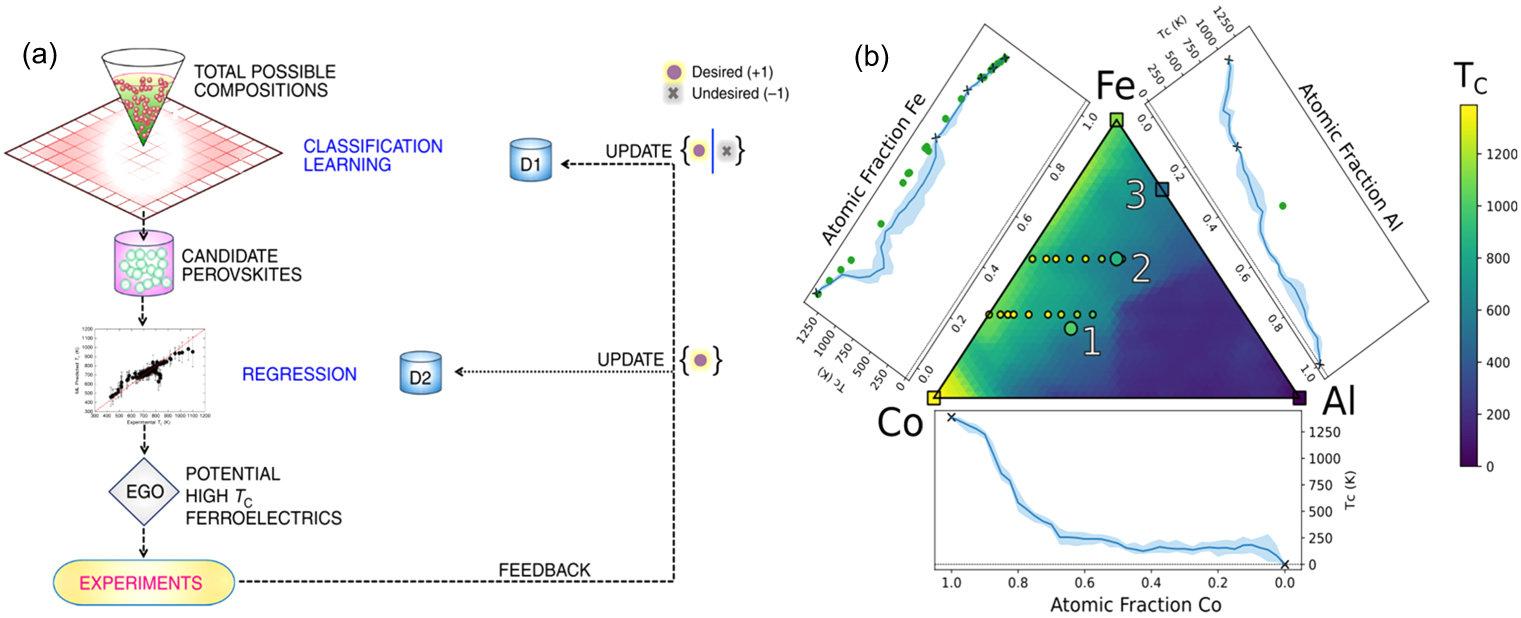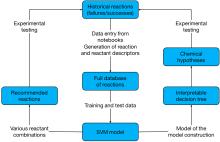中国物理B ›› 2020, Vol. 29 ›› Issue (11): 116103-.doi: 10.1088/1674-1056/abc0e3
所属专题: SPECIAL TOPIC — Machine learning in condensed matter physics
Zhilong Song(宋志龙)1, Xiwen Chen(陈曦雯)1, Fanbin Meng(孟繁斌)1, Guanjian Cheng(程观剑)1, Chen Wang(王陈)1, Zhongti Sun(孙中体)1,†( ), Wan-Jian Yin(尹万健)1,‡(
), Wan-Jian Yin(尹万健)1,‡( )
)
-
收稿日期:2020-07-06修回日期:2020-08-24接受日期:2020-10-14出版日期:2020-11-05发布日期:2020-11-03
Machine learning in materials design: Algorithm and application
Zhilong Song(宋志龙), Xiwen Chen(陈曦雯), Fanbin Meng(孟繁斌), Guanjian Cheng(程观剑), Chen Wang(王陈), Zhongti Sun(孙中体)†, and Wan-Jian Yin(尹万健)‡
- College of Energy, Soochow Institute for Energy and Materials InnovationS (SIEMIS), and Jiangsu Provincial Key Laboratory for Advanced Carbon Materials and Wearable Energy Technologies, Soochow University, Suzhou 215006, China
-
Received:2020-07-06Revised:2020-08-24Accepted:2020-10-14Online:2020-11-05Published:2020-11-03 -
Contact:†Corresponding author. E-mail:ztsun@suda.edu.cn ‡Corresponding author. E-mail:wjyin@suda.edu.cn -
Supported by:Project support by the National Natural Science Foundation of China (Grant Nos. 11674237 and 51602211), the National Key Research and Development Program of China (Grant No. 2016YFB0700700), the Priority Academic Program Development of Jiangsu Higher Education Institutions (PAPD), China, and China Post-doctoral Foundation (Grant No. 7131705619).
引用本文
Zhilong Song(宋志龙), Xiwen Chen(陈曦雯), Fanbin Meng(孟繁斌), Guanjian Cheng(程观剑), Chen Wang(王陈), Zhongti Sun(孙中体), Wan-Jian Yin(尹万健). [J]. 中国物理B, 2020, 29(11): 116103-.
Zhilong Song(宋志龙), Xiwen Chen(陈曦雯), Fanbin Meng(孟繁斌), Guanjian Cheng(程观剑), Chen Wang(王陈), Zhongti Sun(孙中体), and Wan-Jian Yin(尹万健). Machine learning in materials design: Algorithm and application[J]. Chin. Phys. B, 2020, 29(11): 116103-.
"
| Name | Function | URL |
|---|---|---|
| Pymatgen | Robust, open-source python library for materials analysis | https://pymatgen.org |
| AFLOW π | A minimalist framework for high-throughput first principles calculations | http://aflowlib.org/src/aflowpi |
| FireWorks | An open-source code for defining, managing, and executing calculation workflows | https://materialsproject.github.io/fireworks |
| AiiDA | A workflow to automate complex numerical procedures of calculation | http://www.aiida.net |
| Pymatflow | A workflow simplifier for research on materials science by means of ab initio simulation | http://pymatflow.readthedocs.org |
| ASE | Setting up, steering, and analyzing atomistic simulations | https://wiki.fysik.dtu.dk/ase |
| Atomate | Built on top of state-of-the-art open-source libraries: pymatgen, custodian, and FireWorks | https://atomate.org |
| Custodian | A simple, robust, and flexible just-in-time (JIT) job management framework | https://pypi.org/project/custodian |
| MPInterfaces | A python tool that enables high throughput analysis of interfaces using VASP, VASPsol, and MP tools | http://henniggroup.github.io/MPInterfaces |
| Imeall | A database framework for the calculation of the atomistic properties of grain boundaries | https://github.com/Montmorency/imeall |
| Pylada | A modular python framework to control physics simulations | http://pylada.github.io/pylada |
| Pyiron | An integrated development environment (IDE) for computational materials science | https://pyiron.github.io |
"
"
| Name | Description | URL |
|---|---|---|
| QML | A python toolkit for representation learning of properties of molecules and solids | https://www.qmlcode.org |
| AMP | A modular approach to machine learning in atomistic simulations | https://amp.readthedocs.io |
| Magpie | Materials-agnostic platform for informatics and exploration | https://github.com/amarkrishna/demo1 |
| RDkit | A collection of cheminformatics and machine-learning software written in C++ and Python | https://github.com/rdkit/rdkit |
| ChemML | A ML program suite for the analysis, mining, and modeling of chemical and materials data | https://pypi.org/project/chemml |
| DScribe | Library of descriptors for machine learning in materials science | https://singroup.github.io/dscribe |
| Matminer | A Python library for data mining the properties of materials | https://hackingmaterials.lbl.gov/matminer |
| SchNet | A deep learning architecture for quantum chemistry | https://github.com/atomistic-machine-learning/SchNet |
| DeepChem | Deep-learning models for drug discovery and quantum chemistry | http://github.com/deepchem/deepchem |
| MEGNet | An implementation of DeepMind’s graph networks for universal machine learning in materials science | https://github.com/materialsvirtuallab/megnet |
| CGCNN | Implement crystal graph convolutional neural networks to arbitrary crystal structures | https://github.com/txie-93/cgcnn |
"
| Conventional | Deep learning | Tree-based | Descriptor | Active | Unsupervised | |
|---|---|---|---|---|---|---|
| Thermodynamic stability | [ | [ | [ | [ | [ | |
| Band gap | [ | [ | [ | [ | [ | |
| Superconductivity | [ | [ | [ | [ | [ | |
| Thermal conductivity | [ | [ | [ | [ | [ | |
| Curie temperature | [ | [ | [ | [ | ||
| Bulk and shear moduli | [ | [ | [ | [ | ||
| Debye temperature and heat capacity | [ | [ | ||||
| Density of states | [ | [ | [ | |||
| Dielectric breakdown strength | [ | [ | [ | |||
| grain boundary structure and properties | [ | [ | [ | [ | [ | |
| Lattice parameter | [ | [ | ||||
| Lithium ion batteries SOC and conduction | [ | [ | [ | |||
| melting temperature | [ | [ | [ |
| [1] |
Iten R, Metger T, Wilming H, Del Rio L, Renner R 2020 Phys. Rev. Lett. 124 010508 DOI: 10.1103/PhysRevLett.124.010508
|
| [2] |
Oviedo F, Ren Z, Sun S, Settens C, Liu Z, Hartono N T P, Ramasamy S, DeCost B L, Tian S I P, Romano G, Gilad Kusne A, Buonassisi T 2019 npj Comput. Mater. 5 60 DOI: 10.1038/s41524-019-0196-x
|
| [3] |
Ryan K, Lengyel J, Shatruk M 2018 J. Am. Chem. Soc. 140 10158 DOI: 10.1021/jacs.8b03913
|
| [4] |
Ziletti A, Kumar D, Scheffler M, Ghiringhelli L M 2018 Nat. Commun. 9 2775 DOI: 10.1038/s41467-018-05169-6
|
| [5] |
Podryabinkin E V, Tikhonov E V, Shapeev A V, Oganov A R 2019 Phys. Rev. B 99 064114 DOI: 10.1103/PhysRevB.99.064114
|
| [6] |
Balachandran P V, Kowalski B, Sehirlioglu A, Lookman T 2018 Nat. Commun. 9 1668 DOI: 10.1038/s41467-018-03821-9
|
| [7] |
Xu Q, Li Z, Liu M, Yin W J 2018 J. Phys. Chem. Lett. 9 6948 DOI: 10.1021/acs.jpclett.8b03232
|
| [8] |
Fischer C C, Tibbetts K J, Morgan D, Ceder G 2006 Nat. Mater. 5 641 DOI: 10.1038/nmat1691
|
| [9] |
Segler M H S, Preuss M, Waller M P 2018 Nature 555 604 DOI: 10.1038/nature25978
|
| [10] |
Coley C W, Thomas D A, Lummiss J A M, Jaworski J N, Breen C P, Schultz V, Hart T, Fishman J S, Rogers L, Gao H, Hicklin R W, Plehiers P P, Byington J, Piotti J S, Green W H, John Hart A, Jamison T F, Jensen K F 2019 Science 365 eaax1566 DOI: 10.1126/science.aax1566
|
| [11] |
Frey N C, Wang J, Vega Bellido G I, Anasori B, Gogotsi Y, Shenoy V B 2019 ACS Nano 13 3031 DOI: 10.1021/acsnano.8b08014
|
| [12] |
Rao C N R, Natarajan S, Neeraj S 2000 J. Am. Chem. Soc. 122 2810 DOI: 10.1021/ja993892f
|
| [13] |
Kim E, Huang K, Saunders A, McCallum A, Ceder G, Olivetti E 2017 Chem. Mater. 29 9436 DOI: 10.1021/acs.chemmater.7b03500
|
| [14] |
Vasudevan R K, Laanait N, Ferragut E M, Wang K, Geohegan D B, Xiao K, Ziatdinov M, Jesse S, Dyck O, Kalinin S V 2018 npj Comput. Mater. 4 30 DOI: 10.1038/s41524-018-0086-7
|
| [15] |
Maksov A, Dyck O, Wang K, Xiao K, Geohegan D B, Sumpter B G, Vasudevan R K, Jesse S, Kalinin S V, Ziatdinov M 2019 npj Comput. Mater. 5 12 DOI: 10.1038/s41524-019-0152-9
|
| [16] |
Li W, Field K G, Morgan D 2018 npj Comput. Mater. 4 36 DOI: 10.1038/s41524-018-0093-8
|
| [17] |
Sanchez-Gonzalez A, Micaelli P, Olivier C, Barillot T R, Ilchen M, Lutman A A, Marinelli A, Maxwell T, Achner A, Agåker M, Berrah N, Bostedt C, Bozek J D, Buck J, Bucksbaum P H, Montero S C, Cooper B, Cryan J P, Dong M, Feifel R, Frasinski L J, Fukuzawa H, Galler A, Hartmann G, Hartmann N, Helml W, Johnson A S, Knie A, Lindahl A O, Liu J, Motomura K, Mucke M, O’Grady C, Rubensson J E, Simpson E R, Squibb R J, Såthe C, Ueda K, Vacher M, Walke D J, Zhaunerchyk V, Coffee R N, Marangos J P 2017 Nat. Commun. 8 15461 DOI: 10.1038/ncomms15461
|
| [18] |
Ghosh K, Stuke A, Todorović M, Jørgensen P B, Schmidt M N, Vehtari A, Rinke P 2019 Adv. Sci. 6 1801367 DOI: 10.1002/advs.201801367
|
| [19] |
Stanev V, Oses C, Kusne A G, Rodriguez E, Paglione J, Curtarolo S, Takeuchi I 2018 npj Comput. Mater. 4 29 DOI: 10.1038/s41524-018-0085-8
|
| [20] |
Dong Y, Wu C, Zhang C, Liu Y, Cheng J, Lin J 2019 npj Comput. Mater. 5 26 DOI: 10.1038/s41524-019-0165-4
|
| [21] |
Liu Y, Wu J, Wang Z, Lu X G, Avdeev M, Shi S, Wang C, Yu T 2020 Acta Mater. 195 454 DOI: 10.1016/j.actamat.2020.05.001
|
| [22] |
Ng M F, Zhao J, Yan Q, Conduit G J, Seh Z W 2020 Nat. Mach. Intell. 2 161 DOI: 10.1038/s42256-020-0156-7
|
| [23] |
Shen Z H, Wang J J, Jiang J Y, Huang S X, Lin Y H, Nan C W, Chen L Q, Shen Y 2019 Nat. Commun. 10 1843 DOI: 10.1038/s41467-019-09874-8
|
| [24] |
Xue D, Balachandran P V, Hogden J, Theiler J, Xue D, Lookman T 2016 Nat. Commun. 7 11241 DOI: 10.1038/ncomms11241
|
| [25] |
Isayev O, Oses C, Toher C, Gossett E, Curtarolo S, Tropsha A 2017 Nat. Commun. 8 15679 DOI: 10.1038/ncomms15679
|
| [26] |
Ye W, Chen C, Wang Z, Chu I H, Ong S P 2018 Nat. Commun. 9 3800 DOI: 10.1038/s41467-018-06322-x
|
| [27] |
Bartel C J, Sutton C, Goldsmith B R, Ouyang R, Musgrave C B, Ghiringhelli L M, Scheffler M 2019 Sci. Adv. 5 eaav0693 DOI: 10.1126/sciadv.aav0693
|
| [28] |
Liu Y, Wu J, Yang G, Zhao T, Shi S 2019 Sci. Bull. 64 1195 DOI: 10.1016/j.scib.2019.06.026
|
| [29] |
Liu Y, Zhao T, Yang G, Ju W, Shi S 2017 Comput. Mater. Sci. 140 315 DOI: 10.1016/j.commatsci.2017.09.008
|
| [30] |
Cao B, Adutwum L A, Oliynyk A O, Luber E J, Olsen B C, Mar A, Buriak J M 2018 ACS Nano 12 7434 DOI: 10.1021/acsnano.8b04726
|
| [31] |
Li J, Pradhan B, Gaur S, Thomas J 2019 Adv. Energy Mater. 9 1970181 DOI: 10.1002/aenm.201970181
|
| [32] |
Zubatyuk R, Smith J S, Leszczynski J, Isayev O 2019 Sci. Adv. 5 eaav6490 DOI: 10.1126/sciadv.aav6490
|
| [33] |
Ling J, Hutchinson M, Antono E, Paradiso S, Meredig B 2017 Integr. Mater. Manuf. Innov. 6 207 DOI: 10.1007/s40192-017-0098-z
|
| [34] |
Settles B 2012 Synth. Lect. Artif. Intell. Mach. Learn. 6 1 DOI: 10.2200/S00429ED1V01Y201207AIM018
|
| [35] |
Ong S P, Richards W D, Jain A, Hautier G, Kocher M, Cholia S, Gunter D, Chevrier V L, Persson K A, Ceder G 2013 Comput. Mater. Sci. 68 314 DOI: 10.1016/j.commatsci.2012.10.028
|
| [36] |
Pizzi G, Cepellotti A, Sabatini R, Marzari N, Kozinsky B 2016 Comput. Mater. Sci. 111 218 DOI: 10.1016/j.commatsci.2015.09.013
|
| [37] |
Jain A, Ong S P, Chen W, Medasani B, Qu X, Kocher M, Brafman M, Petretto G, Rignanese G M, Hautier G, Gunter D, Persson K A 2015 Concurr. Comput. 27 5037 DOI: 10.1002/cpe.3505
|
| [38] |
Lambert H, Fekete A, Kermode J R, De A 2018 Comput. Phys. Commun. 232 256 DOI: 10.1016/j.cpc.2018.04.029
|
| [39] |
Mathew K, Singh A K, Gabriel J J, Choudhary K, Sinnott S B, Davydov A V, Tavazza F, Hennig R G 2016 Comput. Mater. Sci. 122 183 DOI: 10.1016/j.commatsci.2016.05.020
|
| [40] |
Mathew K, Montoya J H, Faghaninia A, Dwarakanath S, Aykol M, Tang H, heng I, Smidt T, Bocklund B, Horton M, Dagdelen J, Wood B, Liu Z K, Neaton J, Ong S P, Persson K, Jain A 2017 Comput. Mater. Sci. 139 140 DOI: 10.1016/j.commatsci.2017.07.030
|
| [41] |
Supka A R, Lyons T E, Liyanage L, D’Amico P, Al Rahal Al Orabi R, Mahatara S, Gopal P, Toher C, Ceresoli D, Calzolari A, Curtarolo S, Nardelli M B, Fornari M 2017 Comput. Mater. Sci. 136 76 DOI: 10.1016/j.commatsci.2017.03.055
|
| [42] |
Hjorth Larsen A, Jørgen Mortensen J, Blomqvist J, Castelli I E, Christensen R, Dułak M, Friis J, Groves M N, Hammer B, Hargus C, Hermes E D, Jennings P C, Bjerre Jensen P, Kermode J, Kitchin J R, Leonhard Kolsbjerg E, Kubal J, Kaasbjerg K, Lysgaard S, Bergmann Maronsson J, Maxson T, Olsen T, Pastewka L, Peterson A, Rostgaard C, Schiøtz J, Schütt O, Strange M, Thygesen K S, Vegge T, Vilhelmsen L, Walter M, Zeng Z, Jacobsen K W 2017 J. Phys. Condens. Matter 29 273002 DOI: 10.1088/1361-648X/aa680e
|
| [43] |
Janssen J, Surendralal S, Lysogorskiy Y, Todorova M, Hickel T, Drautz R, Neugebauer J 2019 Comput. Mater. Sci. 163 24 DOI: 10.1016/j.commatsci.2018.07.043
|
| [44] |
Jain A, Ong S P, Hautier G, Chen W, Richards W D, Dacek S, Cholia S, Gunter D, Skinner D, Ceder G, Persson K A 2013 APL Mater. 1 011002 DOI: 10.1063/1.4812323
|
| [45] |
Hellenbrandt M 2004 Crystallogr. Rev. 10 17 DOI: 10.1080/08893110410001664882
|
| [46] |
Kirklin S, Saal J E, Meredig B, Thompson A, Doak J W, Aykol M, Rühl S, Wolverton C 2015 npj Comput. Mater. 1 15010 DOI: 10.1038/npjcompumats.2015.10
|
| [47] |
Haastrup S, Strange M, Pandey M, Deilmann T, Schmidt P S, Hinsche N F, Gjerding M N, Torelli D, Larsen P M, Riis-Jensen A C, Gath J, Jacobsen K W, Mortensen J J, Olsen T, Thygesen K S 2018 2D Mater. 5 042002 DOI: 10.1088/2053-1583/aacfc1
|
| [48] |
Stevanović V, Lany S, Zhang X, Zunger A 2012 Phys. Rev. B - Condens. Matter Mater. Phys. 85 115104 DOI: 10.1103/PhysRevB.85.115104
|
| [49] |
Graulis S, Chateigner D, Downs R T, Yokochi A F T, Quirós M, Lutterotti L, Manakova E, Butkus J, Moeck P, Le Bail A 2009 J. Appl. Crystallogr. 42 726 DOI: 10.1107/S0021889809016690
|
| [50] |
Saal J E, Kirklin S, Aykol M, Meredig B, Wolverton C 2013 Jom 65 1501 DOI: 10.1007/s11837-013-0755-4
|
| [51] |
Borysov S S, Geilhufe R M, Balatsky A V 2017 PLoS One 12 e0171501 DOI: 10.1371/journal.pone.0171501
|
| [52] |
Ashton M, Paul J, Sinnott S B, Hennig R G 2017 Phys. Rev. Lett. 118 106101 DOI: 10.1103/PhysRevLett.118.106101
|
| [53] |
Williams A 2008 Chem. Int. 30
|
| [54] |
Choudhary K, Cheon G, Reed E, Tavazza F 2018 Phys. Rev. B 98 014107 DOI: 10.1103/PhysRevB.98.014107
|
| [55] |
Groom C R, Bruno I J, Lightfoot M P, Ward S C 2016 Acta Crystallogr. Sect. B Struct. Sci. Cryst. Eng. Mater. 72 171 DOI: 10.1107/S2052520616003954
|
| [56] |
Sterling T, Irwin J J 2015 J. Chem. Inf. Model. 55 2324 DOI: 10.1021/acs.jcim.5b00559
|
| [57] |
Landis D D, Hummelshøj J S, Nestorov S, Greeley J, Dulłak M, Bligaard T, Nørskov J K, Jacobsen K W 2012 Comput. Sci. Eng. 14 51 DOI: 10.1109/MCSE.2012.16
|
| [58] |
Gorai P, Gao D, Ortiz B, Miller S, Barnett S A, Mason T, Lv Q, Stevanović V, Toberer E S 2016 Comput. Mater. Sci. 112 368 DOI: 10.1016/j.commatsci.2015.11.006
|
| [59] |
Curtarolo S, Setyawan W, Wang S, Xue J, Yang K, Taylor R H, Nelson L J, Hart G L W, Sanvito S, Buongiorno-Nardelli M, Mingo N, Levy O 2012 Comput. Mater. Sci. 58 227 DOI: 10.1016/j.commatsci.2012.02.002
|
| [60] |
Gaulton A, Hersey A, Nowotka M L, Patricia Bento A, Chambers J, Mendez D, Mutowo P, Atkinson F, Bellis L J, Cibrian-Uhalte E, Davies M, Dedman N, Karlsson A, Magarinos M P, Overington J P, Papadatos G, Smit I, Leach A R 2017 Nucleic Acids Res. 45 D945 DOI: 10.1093/nar/gkw1074
|
| [61] |
Zakutayev A, Wunder N, Schwarting M, Perkins J D, White R, Munch K, Tumas W, Phillips C 2018 Sci. Data 5 180053 DOI: 10.1038/sdata.2018.53
|
| [62] |
Ramakrishnan R, Dral P O, Rupp M, Von Lilienfeld O A 2014 Sci. Data 1 140022 DOI: 10.1038/sdata.2014.22
|
| [63] |
Hachmann J, Olivares-Amaya R, Atahan-Evrenk S, Amador-Bedolla C, Sánchez-Carrera R S, Gold-Parker A, Vogt L, Brockway A M, Aspuru-Guzik A 2011 J. Phys. Chem. Lett. 2 2241 DOI: 10.1021/jz200866s
|
| [64] |
Hill J, Mannodi-Kanakkithodi A, Ramprasad R, Meredig B 2018 Computational Materials System Design Cham Springer International Publishing 193 DOI: 10.1007/978-3-319-68280-8_9
|
| [65] |
Fink T, Reymond J 2007 J. Chem. Inf. Model. 47 342 DOI: 10.1021/ci600423u
|
| [66] |
Glasser L 2016 J. Chem. Educ. 93 542 DOI: 10.1021/acs.jchemed.5b00253
|
| [67] |
Puchala B, Tarcea G, Marquis E A, Hedstrom M, Jagadish H V, Allison J E 2016 JOM 68 2035 DOI: 10.1007/s11837-016-1998-7
|
| [68] |
Villars P, Onodera N, Iwata S 1998 J. Alloys Compd. 279 1 DOI: 10.1016/S0925-8388(98)00605-7
|
| [69] |
Tshitoyan V, Dagdelen J, Weston L, Dunn A, Rong Z, Kononova O, Persson K A, Ceder G, Jain A 2019 Nature 571 95 DOI: 10.1038/s41586-019-1335-8
|
| [70] |
Torayev A, Magusin P C M M, Grey C P, Merlet C, Franco A A 2019 J. Phys. Mater. 2 044004 DOI: 10.1088/2515-7639/ab3611
|
| [71] |
Swain M C, Cole J M 2016 J. Chem. Inf. Model. 56 1894 DOI: 10.1021/acs.jcim.6b00207
|
| [72] |
Jessop D M, Adams S E, Murray-Rust P 2011 J. Cheminform. 3 40 DOI: 10.1186/1758-2946-3-40
|
| [73] |
Jones D E, Igo S, Hurdle J, Facelli J C 2014 PLoS One 9 e83932 DOI: 10.1371/journal.pone.0083932
|
| [74] |
Krallinger M, Rabal O, Lourenço A, Oyarzabal J, Valencia A 2017 Chem. Rev. 117 7673 DOI: 10.1021/acs.chemrev.6b00851
|
| [75] |
Jensen Z, Kim E, Kwon S, Gani T Z H, Román-Leshkov Y, Moliner M, Corma A, Olivetti E 2019 ACS Cent. Sci. 5 892 DOI: 10.1021/acscentsci.9b00193
|
| [76] |
Fourches D, Muratov E, Tropsha A 2010 J. Chem. Inf. Model. 50 1189 DOI: 10.1021/ci100176x
|
| [77] |
Wilkinson M D, Dumontier M, Aalbersberg Ij J, Appleton G, Axton M, Baak A, Blomberg N, Boiten J W, da Silva Santos L B, Bourne P E, Bouwman J, Brookes A J, Clark T, Crosas M, Dillo I, Dumon O, Edmunds S, Evelo C T, Finkers R, Gonzalez-Beltran A, Gray A J G, Groth P, Goble C, Grethe J S, Heringa J t, Hoen P A C, Hooft R, Kuhn T, Kok R, Kok J, Lusher S J, Martone M E, Mons A, Packer A L, Persson B, Rocca-Serra P, Roos M, van Schaik R, Sansone S A, Schultes E, Sengstag T, Slater T, Strawn G, Swertz M A, Thompson M, Van Der Lei J, Van Mulligen E, Velterop J, Waagmeester A, Wittenburg P, Wolstencroft K, Zhao J, Mons B 2016 Sci. Data 3 160018 DOI: 10.1038/sdata.2016.18
|
| [78] |
Raccuglia P, Elbert K C, Adler P D F, Falk C, Wenny M B, Mollo A, Zeller M, Friedler S A, Schrier J, Norquist A J 2016 Nature 533 73 DOI: 10.1038/nature17439
|
| [79] |
Yang H, Zhang Z, Zhang J, Zeng X C 2018 Nanoscale 10 19092 DOI: 10.1039/C8NR05703F
|
| [80] |
Gilmer J, Schoenholz S S, Riley P F, Vinyals O, Dahl G E 2017 $34$th Int. Conf. Mach. Learn. ICML 2017 3 2053 DOI: 10.5555/3305381.3305512
|
| [81] |
Balachandran P V, Emery A A, Gubernatis J E, Lookman T, Wolverton C, Zunger A 2018 Phys. Rev. Mater. 2 043802 DOI: 10.1103/PhysRevMaterials.2.043802
|
| [82] |
Kajita S, Ohba N, Jinnouchi R, Asahi R 2017 Sci. Rep. 7 16991 DOI: 10.1038/s41598-017-17299-w
|
| [83] |
Hoffmann J, Maestrati L, Sawada Y, Tang J, Sellier J M, Bengio Y 2019 arXiv:1909.00949 [cs.LG]
|
| [84] |
Weininger D 1988 J. Chem. Inf. Comput. Sci. 28 31 DOI: 10.1021/ci00057a005
|
| [85] |
Rupp M, Tkatchenko A, Müller K R, Von Lilienfeld O A 2012 Phys. Rev. Lett. 108 058301 DOI: 10.1103/PhysRevLett.108.058301
|
| [86] |
Faber F, Lindmaa A, Von Lilienfeld O A, Armiento R 2015 Int. J. Quantum Chem. 115 1094 DOI: 10.1002/qua.24917
|
| [87] |
Schütt K T, Glawe H, Brockherde F, Sanna A, Müller K R, Gross E K U 2014 Phys. Rev. B 89 205118 DOI: 10.1103/PhysRevB.89.205118
|
| [88] |
Huang B, Von Lilienfeld O A 2016 J. Chem. Phys. 145 161102 DOI: 10.1063/1.4964627
|
| [89] |
Hansen K, Biegler F, Ramakrishnan R, Pronobis W, Von Lilienfeld O A, Müller K R, Tkatchenko A 2015 J. Phys. Chem. Lett. 6 2326 DOI: 10.1021/acs.jpclett.5b00831
|
| [90] |
Rogers D, Hahn M 2010 J. Chem. Inf. Model. 50 742 DOI: 10.1021/ci100050t
|
| [91] |
Huo H, Rupp M 2017 arXiv:1704.06439 [physics.chem-ph]
|
| [92] |
Bartók A P, Kondor R, Csányi G 2013 Phys. Rev. B 87 184115 DOI: 10.1103/PhysRevB.87.184115
|
| [93] |
Behler J 2011 J. Chem. Phys. 134 074106 DOI: 10.1063/1.3553717
|
| [94] |
Choudhary K, Decost B, Tavazza F 2018 Phys. Rev. Mater. 2 083801 DOI: 10.1103/PhysRevMaterials.2.083801
|
| [95] |
Mezey Paul G R, Stephen Berry J I B 1994 Graph Theoretical Approaches to Chemical Reactivity Bonchev D, Mekenyan O Dordrecht Springer Netherlands DOI: 10.1007/978-94-011-1202-4
|
| [96] |
Scarselli Franco, Gori Marco, Tsoi Ah Chung, Markus Hagenbuchner G M 2009 IEEE Trans. Neural Networks 20 61 DOI: 10.1109/TNN.2008.2005605
|
| [97] |
Xie T, Grossman J C 2018 Phys. Rev. Lett. 120 145301 DOI: 10.1103/PhysRevLett.120.145301
|
| [98] |
F R S K P 1901 London Edinburgh Dublin Philos. Mag. J. Sci. 2 559 DOI: 10.1080/14786440109462720
|
| [99] |
Khorshidi A, Peterson A A 2016 Comput. Phys. Commun. 207 310 DOI: 10.1016/j.cpc.2016.05.010
|
| [100] |
Ramsundar B, Eastman P, Walters P, Pande V, Leswing K, Wu Z 2019 Deep Learning for the Life Sciences Sebastopol O’Reilly Media
|
| [101] |
Ward L, Dunn A, Faghaninia A, Zimmermann N E R, Bajaj S, Wang Q, Montoya J, Chen J, Bystrom K, Dylla M, Chard K, Asta M, Persson K A, Snyder G J, Foster I, Jain A 2018 Comput. Mater. Sci. 152 60 DOI: 10.1016/j.commatsci.2018.05.018
|
| [102] |
Chen C, Ye W, Zuo Y, Zheng C, Ong S P 2019 Chem. Mater. 31 3564 DOI: 10.1021/acs.chemmater.9b01294
|
| [103] |
Himanen L, Jäger M O J, Morooka E V, Federici Canova F, Ranawat Y S, Gao D Z, Rinke P, Foster A S 2020 Comput. Phys. Commun. 247 106949 DOI: 10.1016/j.cpc.2019.106949
|
| [104] |
Schütt K T, Sauceda H E, Kindermans P J, Tkatchenko A, Müller K R 2018 J. Chem. Phys. 148 241722 DOI: 10.1063/1.5019779
|
| [105] |
Landrum G 2016 rdkit: open source cheminformatics software
|
| [106] |
Ward L, Agrawal A, Choudhary A, Wolverton C 2016 npj Comput. Mater. 2 16028 DOI: 10.1038/npjcompumats.2016.28
|
| [107] |
Haghighatlari M, Vishwakarma G, Altarawy D, Subramanian R, Kota B U, Sonpal A, Setlur S, Hachmann J 2020 WIREs Comput. Mol. Sci. 10 e1458
|
| [108] |
McKinney W 2011 Python High Perform. Sci. Comput. 14 DOI: 10.4018/978-1-5225-9902-9.ch008
|
| [109] |
Baranwal A, Bagwe B R, and M V 2011 J. Mach. Learn. Res. 12 128
|
| [110] |
Abadi M, Barham P, Chen J, Chen Z, Davis A, Dean J, Devin M, Ghemawat S, Irving G, Isard M others 2016 12th USENIX Symposium on Operating Systems Design and Implementation (OSDI’16) 265 DOI: 10.1002/adts.201900215
|
| [111] |
Paszke A, Gross S, Massa F, Lerer A, Bradbury J, Chanan G, Killeen T, Lin Z, Gimelshein N, Antiga L, Desmaison A, Kopf A, Yang E, DeVito Z, Raison M, Tejani A, Chilamkurthy S, Steiner B, Fang L, Bai J, Chintala S 2019 Advances in Neural Information Processing Systems 32 Wallach H, Larochelle H, Beygelzimer A, Alché-Buc F, Fox E, Garnett R Curran Associates, Inc.
|
| [112] |
Liu Y, Wu J, Avdeev M, Shi S 2020 Adv. Theory Simul. 3 1900215 DOI: 10.1002/adts.201900215
|
| [113] |
Chauhan N K, Singh K 2019 2018 International Conference on Computing, Power and Communication Technologies, GUCON 2018 IEEE
|
| [114] |
Schneider A, Hommel G, Blettner M 2010 Dtsch. Arztebl. 107 776 DOI: 10.3238/arztebl.2010.0776
|
| [115] |
Tibshirani R 1996 J. R. Stat. Soc. Ser. B 58 267 DOI: 10.1111/j.2517-6161.1996.tb02080.x
|
| [116] |
Hoerl A E, Kennard R W 1970 Technometrics 12 55 DOI: 10.1080/00401706.1970.10488634
|
| [117] |
Zou H, Hastie T 2005 J. R. Stat. Soc. Ser. B 67 301 DOI: 10.1111/j.1467-9868.2005.00503.x
|
| [118] |
Murphy K P 2012 Machine Learning: A Probabilistic Perspective Cambridge The MIT Press
|
| [119] |
A Smola B S 2004 Stat. Comput. 14 199 DOI: 10.1023/B:STCO.0000035301.49549.88
|
| [120] |
Cortes C, Vapnik V 1995 Mach. Learn. 20 273 DOI: 10.1007/BF00994018
|
| [121] |
O’Shea K, Nash R 2015 arXiv:1511.08458 [cs.NE]
|
| [122] |
Lecun Y, Bengio Y, Hinton G 2015 Nature 521 436 DOI: 10.1038/nature14539
|
| [123] |
Nielsen M A 2018 Neural Networks and Deep Learning Determination Press
|
| [124] |
Quinlan J R 1987 Int. J. Man. Mach. Stud. 27 221 DOI: 10.1016/S0020-7373(87)80053-6
|
| [125] |
Prokhorenkova L, Gusev G, Vorobev A, Dorogush A V, Gulin A 2018 Advances in neural information processing systems 6638 DOI: 10.1145/2939672.2939785
|
| [126] |
Ke G, Meng Q, Finley T, Wang T, Chen W, Ma W, Ye Q, Liu T Y 2017 Advances in Neural Information Processing Systems 30 Guyon I, Luxburg U V, Bengio S, Wallach H, Fergus R, Vishwanathan S, Garnett R Curran Associates, Inc.
|
| [127] |
Freund Y, Schapire R E 1996 Proc. 13th Int. Conf. Mach. Learn. 148 DOI: 10.5555/3091696.3091715
|
| [128] |
Chen T, Guestrin C 2016 Proceedings of the 22nd ACM SIGKDD International Conference on Knowledge Discovery and Data Mining KDD’16 New York, NY, USA ACM 785 DOI: 10.1145/2939672.2939785
|
| [129] |
Xuan P, Sun C, Zhang T, Ye Y, Shen T, Dong Y 2019 Front. Genet. 10 459 DOI: 10.3389/fgene.2019.00459
|
| [130] |
Liaw A, Wiener M 2002 R News 2 18
|
| [131] |
Rabiner L, Juang B 1986 IEEE ASSP Mag. 3 4 DOI: 10.1109/MASSP.1986.1165342
|
| [132] |
Kingma D P, Welling M 2019 Found. Trends®Mach. Learn. 12 307 DOI: 10.1561/2200000056
|
| [133] |
Creswell A, White T, Dumoulin V, Arulkumaran K, Sengupta B, Bharath A A 2018 IEEE Signal Process. Mag. 35 53 DOI: 10.1109/MSP.2017.2765202
|
| [134] |
Ouyang R, Curtarolo S, Ahmetcik E, Scheffler M, Ghiringhelli L M 2018 Phys. Rev. Mater. 2 83802 DOI: 10.1103/PhysRevMaterials.2.083802
|
| [135] |
Augusto D A, Barbosa H J C 2000 Proceedings. Vol. 1. Sixth Brazilian Symposium on Neural Networks vol 2000-Janua IEEE Comput. Soc
|
| [136] |
Wang Y, Wagner N, Rondinelli J M 2019 MRS Commun. 9 793 DOI: 10.1557/mrc.2019.85
|
| [137] |
Udrescu S M, Tegmark M 2020 Sci. Adv. 6 eaay2631 DOI: 10.1126/sciadv.aay2631
|
| [138] |
Dubčáková R 2011 Genet. Program. Evolvable Mach. 12 173 DOI: 10.1007/s10710-010-9124-z
|
| [139] |
Fan J, Lv J 2008 J. R. Stat. Soc. Ser. B 70 849 DOI: 10.1111/j.1467-9868.2008.00674.x
|
| [140] |
Eldar Y C, Kutyniok G 2012 Compressed Sensing: Theory and Applications Cambridge Cambridge University Press
|
| [141] |
Ghiringhelli L M, Vybiral J, Ahmetcik E, Ouyang R, Levchenko S V, Draxl C, Scheffler M 2017 New J. Phys. 19 023017 DOI: 10.1088/1367-2630/aa57bf
|
| [142] |
Pankajakshan P, Sanyal S, De Noord O E, Bhattacharya I, Bhattacharyya A, Waghmare U 2017 Chem. Mater. 29 4190 DOI: 10.1021/acs.chemmater.6b04229
|
| [143] |
Settles B 2012 Active Learning San Rafael Morgan & Claypool Publishers
|
| [144] |
Gubaev K, Podryabinkin E V, Shapeev A V 2018 J. Chem. Phys. 148 241727 DOI: 10.1063/1.5005095
|
| [145] |
Tran K, Ulissi Z W 2018 Nat. Catal. 1 696 DOI: 10.1038/s41929-018-0142-1
|
| [146] |
Yuan R, Liu Z, Balachandran P V, Xue D, Zhou Y, Ding X, Sun J, Xue D, Lookman T 2018 Adv. Mater. 30 1702884 DOI: 10.1002/adma.201702884
|
| [147] |
Botu V, Ramprasad R 2015 Int. J. Quantum Chem. 115 1074 DOI: 10.1002/qua.24836
|
| [148] |
Le T T, Fu W, Moore J H 2020 Bioinformatics 36 250 DOI: 10.1093/bioinformatics/btz470
|
| [149] |
Zhong M, Tran K, Min Y, Wang C, Wang Z, Dinh C T, De Luna P, Yu Z, Rasouli A S, Brodersen P, Sun S, Voznyy O, Tan C S, Askerka M, Che F, Liu M, Seifitokaldani A, Pang Y, Lo S C, Ip A, Ulissi Z, Sargent E H 2020 Nature 581 178 DOI: 10.1038/s41586-020-2242-8
|
| [150] |
Chen X, Wang C, Li Z, Hou Z, Yin W J 2020 Sci. Chin. Mater. 63 1024 DOI: 10.1007/s40843-019-1255-4
|
| [151] |
Dieb T M, Ju S, Shiomi J, Tsuda K 2019 MRS Commun. 9 532 DOI: 10.1557/mrc.2019.40
|
| [152] |
Dieb T M, Hou Z, Tsuda K 2018 J. Chem. Phys. 148 241716 DOI: 10.1063/1.5018065
|
| [153] |
M Dieb T, Ju S, Yoshizoe K, Hou Z, Shiomi J, Tsuda K 2017 Sci. Technol. Adv. Mater. 18 498 DOI: 10.1080/14686996.2017.1344083
|
| [154] |
Mnih V, Kavukcuoglu K, Silver D, Rusu A A, Veness J, Bellemare M G, Graves A, Riedmiller M, Fidjeland A K, Ostrovski G, Petersen S, Beattie C, Sadik A, Antonoglou I, King H, Kumaran D, Wierstra D, Legg S, Hassabis D 2015 Nature 518 529 DOI: 10.1038/nature14236
|
| [155] |
Meredig B, Antono E, Church C, Hutchinson M, Ling J, Paradiso S, Blaiszik B, Foster I, Gibbons B, Hattrick-Simpers J, Mehta A, Ward L 2018 Mol. Syst. Eng. 3 819 DOI: 10.1039/C8ME00012C
|
| [156] |
Butler K T, Davies D W, Cartwright H, Isayev O, Walsh A 2018 Nature 559 547 DOI: 10.1038/s41586-018-0337-2
|
| [157] |
Bergstra J, Bengio Y 2012 J. Mach. Learn. Res. 13 281 DOI: 10.1088/1749-4699/8/1/014008
|
| [158] |
Gao Y, Yang H, Zhang P, Zhou C, Hu Y 2019 5th International Conference on Learning Representations, ICLR 2017 - Conference Track Proceedings 1
|
| [159] |
Liaw R, Liang E, Nishihara R, Moritz P, Gonzalez J E, Stoica I 2018 arXiv:1807.05118 [cs.LG]
|
| [160] |
Microsoft 2020 NNI (Neural Network Intelligence)
|
| [161] |
Bergstra J, Komer B, Eliasmith C, Yamins D, Cox D D 2015 Comput. Sci. Discov. 8 014008 DOI: 10.1088/1749-4699/8/1/014008
|
| [162] |
Jacobs R, Mayeshiba T, Afflerbach B, Miles L, Williams M, Turner M, Finkel R, Morgan D 2020 Comput. Mater. Sci. 176 109544 DOI: 10.1016/j.commatsci.2020.109544
|
| [163] |
Srivastava N, Hinton G, Krizhevsky A, Sutskever I, Salakhutdinov R 2014 J. Mach. Learn. Res. 15 1929 DOI: 10.5555/2627435.2670313
|
| [164] |
Oliynyk A O, Adutwum L A, Harynuk J J, Mar A 2016 Chem. Mater. 28 6672 DOI: 10.1021/acs.chemmater.6b02905
|
| [165] |
Oliynyk A O, Adutwum L A, Rudyk B W, Pisavadia H, Lotfi S, Hlukhyy V, Harynuk J J, Mar A, Brgoch J 2017 J. Am. Chem. Soc. 139 17870 DOI: 10.1021/jacs.7b08460
|
| [166] |
Graser J, Kauwe S K, Sparks T D 2018 Chem. Mater. 30 3601 DOI: 10.1021/acs.chemmater.7b05304
|
| [167] |
Chawla N V, Bowyer K W, Hall L O, Kegelmeyer W P 2002 J. Artif. Int. Res. 16 321 DOI: 10.5555/1622407.1622416
|
| [168] |
Park W B, Chung J, Jung J, Sohn K, Singh S P, Pyo M, Shin N, Sohn K S 2017 IUCrJ. 4 486 DOI: 10.1107/S205225251700714X
|
| [169] |
Oganov A R, Glass C W 2006 J. Chem. Phys. 124 244704 DOI: 10.1063/1.2210932
|
| [170] |
Oganov A R, Lyakhov A O, Valle M 2011 Acc. Chem. Res. 44 227 DOI: 10.1021/ar1001318
|
| [171] |
Lyakhov A O, Oganov A R, Stokes H T, Zhu Q 2013 Comput. Phys. Commun. 184 1172 DOI: 10.1016/j.cpc.2012.12.009
|
| [172] |
Wu S Q, Ji M, Wang C Z, Nguyen M C, Zhao X, Umemoto K, Wentzcovitch R M, Ho K M 2014 J. Phys.: Condens. Matter 26 035402 DOI: 10.1088/0953-8984/26/3/035402
|
| [173] |
Wang Y, Lv J, Zhu L, Ma Y 2010 Phys. Rev. B 82 094116 DOI: 10.1103/PhysRevB.82.094116
|
| [174] |
Wang Y, Lv J, Zhu L, Ma Y 2012 Comput. Phys. Commun. 183 2063 DOI: 10.1016/j.cpc.2012.05.008
|
| [175] |
Tian Y, Sun W, Chen B, Jin Y, Lu C 2019 Chin. Phys. B 28 103104 DOI: 10.1088/1674-1056/ab4274
|
| [176] |
Tang C, Kour G, Du A 2019 Chin. Phys. B 28 107306 DOI: 10.1088/1674-1056/ab41ea
|
| [177] |
Pickard C J, Needs R J 2011 J. Phys.: Condens. Matter 23 053201 DOI: 10.1088/0953-8984/23/5/053201
|
| [178] |
Doll K, Schön J C, Jansen M 2007 Phys. Chem. Chem. Phys. 9 6128 DOI: 10.1039/b709943f
|
| [179] |
Kirkpatrick S, Gelatt C D, Vecchi M P 1983 Science 220 671 DOI: 10.1126/science.220.4598.671
|
| [180] |
Wille L T 1987 Nature 325 374 DOI: 10.1038/325374c0
|
| [181] |
Wales D J, Doye J P K 1997 J. Phys. Chem. A 101 5111 DOI: 10.1021/jp970984n
|
| [182] |
Heiles S, Johnston R L 2013 Int. J. Quantum Chem. 113 2091 DOI: 10.1002/qua.24462
|
| [183] |
Burnham C J, English N J 2019 J. Chem. Theory Comput. 15 3889 DOI: 10.1021/acs.jctc.9b00073
|
| [184] |
Amsler M, Goedecker S 2010 J. Chem. Phys. 133 224104 DOI: 10.1063/1.3512900
|
| [185] |
Goedecker S 2004 J. Chem. Phys. 120 9911 DOI: 10.1063/1.1724816
|
| [186] |
Yamashita T, Sato N, Kino H, Miyake T, Tsuda K, Oguchi T 2018 Phys. Rev. Mater. 2 013803 DOI: 10.1103/PhysRevMaterials.2.013803
|
| [187] |
Seko A, Ishiwata S 2020 Phys. Rev. B 101 134101 DOI: 10.1103/PhysRevB.101.134101
|
| [188] |
Li W, Jacobs R, Morgan D 2018 Comput. Mater. Sci. 150 454 DOI: 10.1016/j.commatsci.2018.04.033
|
| [189] |
Ward L, Liu R, Krishna A, Hegde V I, Agrawal A, Choudhary A, Wolverton C 2017 Phys. Rev. B 96 024104 DOI: 10.1103/PhysRevB.96.024104
|
| [190] |
Schmidt J, Shi J, Borlido P, Chen L, Botti S, Marques M A L 2017 Chem. Mater. 29 5090 DOI: 10.1021/acs.chemmater.7b00156
|
| [191] |
Faber F A, Lindmaa A, Von Lilienfeld O A, Armiento R 2016 Phys. Rev. Lett. 117 135502 DOI: 10.1103/PhysRevLett.117.135502
|
| [192] |
Li Z, Xu Q, Sun Q, Hou Z, Yin W J 2019 Adv. Funct. Mater. 29 1807280 DOI: 10.1002/adfm.201807280
|
| [193] |
Stanley J C, Mayr F, Gagliardi A 2020 Adv. Theory Simul. 3 1900178 DOI: 10.1002/adts.201900178
|
| [194] |
Schmidt J, Chen L, Botti S, Marques M A L 2018 J. Chem. Phys. 148 241728 DOI: 10.1063/1.5020223
|
| [195] |
Schleder G R, Acosta C M, Fazzio A 2020 ACS Appl. Mater. Interfaces 12 20149 DOI: 10.1021/acsami.9b14530
|
| [196] |
Kailkhura B, Gallagher B, Kim S, Hiszpanski A, Han T Y J 2019 npj Comput. Mater. 5 108 DOI: 10.1038/s41524-019-0248-2
|
| [197] |
Pilania G, Mannodi-Kanakkithodi A, Uberuaga B P, Ramprasad R, Gubernatis J E, Lookman T 2016 Sci. Rep. 6 19375 DOI: 10.1038/srep19375
|
| [198] |
Lee J, Seko A, Shitara K, Nakayama K, Tanaka I 2016 Phys. Rev. B 93 115104 DOI: 10.1103/PhysRevB.93.115104
|
| [199] |
Pilania G, Gubernatis J E, Lookman T 2017 Comput. Mater. Sci. 129 156 DOI: 10.1016/j.commatsci.2016.12.004
|
| [200] |
Rajan A C, Mishra A, Satsangi S, Vaish R, Mizuseki H, Lee K R, Singh A K 2018 Chem. Mater. 30 4031 DOI: 10.1021/acs.chemmater.8b00686
|
| [201] |
Weston L, Stampfl C 2018 Phys. Rev. Mater. 2 085407 DOI: 10.1103/PhysRevMaterials.2.085407
|
| [202] |
Zhuo Y, Mansouri Tehrani A, Brgoch J 2018 J. Phys. Chem. Lett. 9 1668 DOI: 10.1021/acs.jpclett.8b00124
|
| [203] |
Olsthoorn B, Geilhufe R M, Borysov S S, Balatsky A V 2019 Adv. Quantum Technol. 2 1900023 DOI: 10.1002/qute.201900023
|
| [204] |
Lu S, Zhou Q, Ouyang Y, Guo Y, Li Q, Wang J 2018 Nat. Commun. 9 3405 DOI: 10.1038/s41467-018-05761-w
|
| [205] |
Gómez-Bombarelli R, Wei J N, Duvenaud D, Hernández-Lobato J M, Sánchez-Lengeling B, Sheberla D, Aguilera-Iparraguirre J, Hirzel T D, Adams R P, Aspuru-Guzik A 2018 ACS Cent. Sci. 4 268 DOI: 10.1021/acscentsci.7b00572
|
| [206] |
Dey P, Bible J, Datta S, Broderick S, Jasinski J, Sunkara M, Menon M, Rajan K 2014 Comput. Mater. Sci. 83 185 DOI: 10.1016/j.commatsci.2013.10.016
|
| [207] |
Ziatdinov M, Maksov A, Li L, Sefat A S, Maksymovych P, Kalinin S V 2016 Nanotechnology 27 475706 DOI: 10.1088/0957-4484/27/47/475706
|
| [208] |
Owolabi T O, Akande K O, Olatunji S O 2014 Adv. Phys. Theor. Appl. 35 12
|
| [209] |
Owolabi T O, Akande K O, Olatunji S O 2015 J. Supercond. Nov. Magn. 28 75 DOI: 10.1007/s10948-014-2891-7
|
| [210] |
Liu Y, Zhang H, Xu Y, Li S, Dai D, Li C, Ding G, Shen W, Qian Q 2018 Mater. Tehnol. 52 639 DOI: 10.17222/mit.2018.043
|
| [211] |
Le T D, Noumeir R, Quach H L, Kim J H, Kim J H, Kim H M 2020 IEEE Trans. Appl. Supercond. 30 1 DOI: 10.1109/TIA.2019.2957707
|
| [212] |
Konno T, Kurokawa H, Nabeshima F, Sakishita Y, Ogawa R, Hosako I, Atsutaka 2018 arxiv: 1812.01995
|
| [213] |
Hamidieh K 2018 Comput. Mater. Sci. 154 346 DOI: 10.1016/j.commatsci.2018.07.052
|
| [214] |
Matsumoto K, Horide T 2019 Appl. Phys. Express 12 073003 DOI: 10.7567/1882-0786/ab2922
|
| [215] |
Xie S R, Stewart G R, Hamlin J J, Hirschfeld P J, Hennig R G 2019 Phys. Rev. B 100 174513 DOI: 10.1103/PhysRevB.100.174513
|
| [216] |
Roekeghem A, Carrete J, Oses C, Curtarolo S, Mingo N 2016 Phys. Rev. X 6 041061 DOI: 10.1103/PhysRevX.6.041061
|
| [217] |
Zhan T, Fang L, Xu Y 2017 Sci. Rep. 7 7109 DOI: 10.1038/s41598-017-07150-7
|
| [218] |
Wei H, Zhao S, Rong Q, Bao H 2018 Int. J. Heat Mass Transf. 127 908 DOI: 10.1016/j.ijheatmasstransfer.2018.08.082
|
| [219] |
Qian X, Peng S, Li X, Wei Y, Yang R 2019 Mater. Today Phys. 10 100140 DOI: 10.1016/j.mtphys.2019.100140
|
| [220] |
Sosso G C, Deringer V L, Elliott S R, Csányi G 2018 Mol. Simul. 44 866 DOI: 10.1080/08927022.2018.1447107
|
| [221] |
Seko A, Hayashi H, Nakayama K, Takahashi A, Tanaka I 2017 Phys. Rev. B 95 144110 DOI: 10.1103/PhysRevB.95.144110
|
| [222] |
Wan J, Jiang J W, Park H S 2020 Carbon N. Y. 157 262 DOI: 10.1016/j.carbon.2019.10.037
|
| [223] |
Li R, Lee E, Luo T 2020 Mater. Today Phys. 12 100181 DOI: 10.1016/j.mtphys.2020.100181
|
| [224] |
Gaultois M W, Oliynyk A O, Mar A, Sparks T D, Mulholland G J, Meredig B 2016 APL Mater. 4 053213 DOI: 10.1063/1.4952607
|
| [225] |
Carrete J, Li W, Mingo N, Wang S, Curtarolo S 2014 Phys. Rev. X 4 011019 DOI: 10.1103/PhysRevX.4.011019
|
| [226] |
Wu Y J, Sasaki M, Goto M, Fang L, Xu Y 2018 ACS Appl. Nano Mater. 1 3355 DOI: 10.1021/acsanm.8b0057510.1038/s41524-019-0193-0
|
| [227] |
Wu Y J, Fang L, Xu Y 2019 npj Comput. Mater. 5 56 DOI: 10.1038/s41524-019-0193-010.1103/PhysRevX.7.021024
|
| [228] |
Ju S, Shiga T, Feng L, Hou Z, Tsuda K, Shiomi J 2017 Phys. Rev. X 7 021024 DOI: 10.1103/PhysRevX.7.021024
|
| [229] |
Ju S, Tsuda K, Shiomi J, Dieb T M 2018 32nd Conference on Neural Information Processing Systems (NIPS 2018)
|
| [230] |
Wei H, Bao H, Ruan X 2020 Nano Energy 71 104619 DOI: 10.1016/j.nanoen.2020.104619
|
| [231] |
Balachandran P V 2020 J. Mater. Res. 35 890 DOI: 10.1557/jmr.2020.38
|
| [232] |
Balachandran P V, Xue D, Lookman T 2016 Phys. Rev. B 93 144111 DOI: 10.1103/PhysRevB.93.144111
|
| [233] |
Dam H C, Nguyen V C, Pham T L, Nguyen A T, Terakura K, Miyake T, Kino H 2018 J. Phys. Soc. Jpn. 87 113801 DOI: 10.7566/JPSJ.87.113801
|
| [234] |
Nguyen D N, Pham T L, Nguyen V C, Nguyen A T, Kino H, Miyake T, Dam H C 2019 J. Phys. Conf. Ser. 1290 012009 DOI: 10.1088/1742-6596/1290/1/012009
|
| [235] |
Zhai X, Chen M, Lu W 2018 Comput. Mater. Sci. 151 41 DOI: 10.1016/j.commatsci.2018.04.031
|
| [236] |
Nelson J, Sanvito S 2019 Phys. Rev. Mater. 3 104405 DOI: 10.1103/PhysRevMaterials.3.104405
|
| [237] |
Zhang B, Zheng X Q, Zhao T Y, Hu F X, Sun J R, Shen B G 2018 Chin. Phys. B 27 067503 DOI: 10.1088/1674-1056/27/6/067503
|
| [238] |
De Jong M, Chen W, Notestine R, Persson K, Ceder G, Jain A, Asta M, Gamst A 2016 Sci. Rep. 6 34256 DOI: 10.1038/srep34256
|
| [239] |
Furmanchuk A, Agrawal A, Choudhary A 2016 RSC Adv. 6 95246 DOI: 10.1039/C6RA19284J
|
| [240] |
Mansouri Tehrani A, Oliynyk A O, Parry M, Rizvi Z, Couper S, Lin F, Miyagi L, Sparks T D, Brgoch J 2018 J. Am. Chem. Soc. 140 9844 DOI: 10.1021/jacs.8b02717
|
| [241] |
Chapman J, Batra R, Ramprasad R 2020 Comput. Mater. Sci. 174 109483 DOI: 10.1016/j.commatsci.2019.109483
|
| [242] |
Kauwe S K, Graser J, Murdock R, Sparks T D 2020 Comput. Mater. Sci. 174 109498 DOI: 10.1016/j.commatsci.2019.109498
|
| [243] |
Zhao Y, Yuan K, Liu Y, Louis S Y, Hu M, Hu J 2020 arXiv:2003.13425 [cond-mat.mtrl-sci]
|
| [244] |
Evans J D, Coudert F X 2017 Chem. Mater. 29 7833 DOI: 10.1021/acs.chemmater.7b02532
|
| [245] |
Kim G, Diao H, Lee C, Samaei A T, Phan T, de Jong M, An K, Ma D, Liaw P K, Chen W 2019 Acta Mater. 181 124 DOI: 10.1016/j.actamat.2019.09.026
|
| [246] |
Xiong J, Shi S Q, Zhang T Y 2020 Materials & Design 187 108378 DOI: 10.1016/j.matdes.2019.108378
|
| [247] |
Zhuo Y, Mansouri Tehrani A, Oliynyk A O, Duke A C, Brgoch J 2018 Nat. Commun. 9 4377 DOI: 10.1038/s41467-018-06625-z
|
| [248] |
Kauwe S K, Graser J, Vazquez A, Sparks T D 2018 Integr. Mater. Manuf. Innov. 7 43 DOI: 10.1007/s40192-018-0108-9
|
| [249] |
Yeo B C, Kim D, Kim C, Han S S 2019 Sci. Rep. 9 5879 DOI: 10.1038/s41598-019-42277-9
|
| [250] |
Umeno Y, Kubo A 2019 Comput. Mater. Sci. 168 164 DOI: 10.1016/j.commatsci.2019.06.005
|
| [251] |
Chandrasekaran A, Kamal D, Batra R, Kim C, Chen L, Ramprasad R 2019 npj Comput. Mater. 5 22 DOI: 10.1038/s41524-019-0162-7
|
| [252] |
Broderick S R, Aourag H, Rajan K 2011 J. Am. Ceram. Soc. 94 2974 DOI: 10.1111/j.1551-2916.2011.04476.x
|
| [253] |
Yuan F, Mueller T 2017 Sci. Rep. 7 17594 DOI: 10.1038/s41598-017-17535-3
|
| [254] |
Kim C, Pilania G, Ramprasad R 2016 J. Phys. Chem. C 120 14575 DOI: 10.1021/acs.jpcc.6b05068
|
| [255] |
Kim C, Pilania G, Ramprasad R 2016 Chem. Mater. 28 1304 DOI: 10.1021/acs.chemmater.5b04109
|
| [256] |
Wu X, Wang Y X, He K N, Li X, Liu W, Zhang Y, Xu Y, Liu C 2020 Mater. (Basel). 13 179 DOI: 10.3390/ma13010179
|
| [257] |
Huber L, Hadian R, Grabowski B, Neugebauer J 2018 npj Comput. Mater. 4 64 DOI: 10.1038/s41524-018-0122-7
|
| [258] |
Rosenbrock C W, Homer E R, Csányi G, Hart G L W 2017 npj Comput. Mater. 3 29 DOI: 10.1038/s41524-017-0027-x
|
| [259] |
Kiyohara S, Oda H, Miyata T, Mizoguchi T 2016 Sci. Adv. 2 e1600746 DOI: 10.1126/sciadv.1600746
|
| [260] |
Homer E R, Hensley D M, Rosenbrock C W, Nguyen A H, Hart G L W 2019 Front. Mater. 6 168 DOI: 10.3389/fmats.2019.00168
|
| [261] |
Kiyohara S, Oda H, Tsuda K, Mizoguchi T 2016 Jpn. J. Appl. Phys. 55 45502 DOI: 10.7567/JJAP.55.045502
|
| [262] |
Kikuchi S, Oda H, Kiyohara S, Mizoguchi T 2018 Phys. B Condens. Matter 532 24 DOI: 10.1016/j.physb.2017.03.006
|
| [263] |
Zhu Q, Samanta A, Li B, Rudd R E, Frolov T 2018 Nat. Commun. 9 467 DOI: 10.1038/s41467-018-02937-2
|
| [264] |
Alade I O, Olumegbon I A, Bagudu A 2020 J. Appl. Phys. 127 015303 DOI: 10.1063/1.5130664
|
| [265] |
Pilania G, Liu X Y 2018 J. Mater. Sci. 53 6652 DOI: 10.1007/s10853-018-1987-z
|
| [266] |
Liu Y, Zhao T, Ju W, Shi S 2017 J. Materiomics 3 159 DOI: 10.1016/j.jmat.2017.08.002
|
| [267] |
Hannan M A, Lipu M S H, Hussain A, Ker P J, Mahlia T M I, Mansor M, Ayob A, Saad M H, Dong Z Y 2020 Sci. Rep. 10 4687 DOI: 10.1038/s41598-020-61464-7
|
| [268] |
Xu Y, Hu M, Zhou A, Li Y, Li S, Fu C, Gong C 2020 Appl. Math. Model. 77 1255 DOI: 10.1016/j.apm.2019.09.011
|
| [269] |
Shen Y 2020 Electrochim. Acta 336 135664 DOI: 10.1016/j.electacta.2020.135664
|
| [270] |
Wang C, Aoyagi K, Wisesa P, Mueller T 2020 Chem. Mater. 32 3741 DOI: 10.1021/acs.chemmater.9b04663
|
| [271] |
Li S, Li J, He H, Wang H 2019 Energy Procedia 159 168 DOI: 10.1016/j.egypro.2018.12.046
|
| [272] |
Sendek A D, Cubuk E D, Antoniuk E R, Cheon G, Cui Y, Reed E J 2019 Chem. Mater. 31 342 DOI: 10.1021/acs.chemmater.8b03272
|
| [273] |
Attarian Shandiz M, Gauvin R 2016 Comput. Mater. Sci. 117 270 DOI: 10.1016/j.commatsci.2016.02.021
|
| [274] |
Shi S, Gao J, Liu Y, Zhao Y, Wu Q, Ju W, Ouyang C, Xiao R 2016 Chin. Phys. B 25 018212 DOI: 10.1088/1674-1056/25/1/018212
|
| [275] |
Chemali E, Kollmeyer P J, Preindl M, Emadi A 2018 J. Power Sources 400 242 DOI: 10.1016/j.jpowsour.2018.06.104
|
| [276] |
Bian C, He H, Yang S 2020 Energy 191 116538 DOI: 10.1016/j.energy.2019.116538
|
| [277] |
Wang W, Brady N W, Liao C, Fahmy Y A, Chemali E, West A C, M 2019 arxiv: 1909.02448
|
| [278] |
Sidhu M S, Ronanki D, Williamson S 2019 IECON 2019 - 45th Annu. Conf. IEEE Ind. Electron. Soc. 1 2732 DOI: 10.1109/iecon.2019.8927066
|
| [279] |
Sivaraman G, Jackson N E, Sanchez-Lengeling B, Vázquez-Mayagoitia A, Aspuru-Guzik A, Vishwanath V, De Pablo J J 2019 chemrxiv.9914378.v1
|
| [280] |
Qu N, Liu Y, Liao M, Lai Z, Zhou F, Cui P, Han T, Yang D, Zhu J 2019 Ceram. Int. 45 18551 DOI: 10.1016/j.ceramint.2019.06.076
|
| [281] |
Pilania G, Gubernatis J E, Lookman T 2015 Phys. Rev. B 91 214302 DOI: 10.1103/PhysRevB.91.214302
|
| [282] |
Seko A, Maekawa T, Tsuda K, Tanaka I 2014 Phys. Rev. B 89 054303 DOI: 10.1103/PhysRevB.89.054303
|
| [283] |
Jacobs R, Mayeshiba T, Booske J, Morgan D 2018 Adv. Energy Mater. 8 1702708 DOI: 10.1002/aenm.201702708
|
| [284] |
Sun Q, Yin W J 2017 J. Am. Chem. Soc. 139 14905 DOI: 10.1021/jacs.7b09379
|
| [285] |
De S, Bartók A P, Csányi G, Ceriotti M 2016 Phys. Chem. Chem. Phys. 18 13754 DOI: 10.1039/C6CP00415F
|
| [286] |
Jäger M O J, Morooka E V, Federici Canova F, Himanen L, Foster A S 2018 npj Comput. Mater. 4 37 DOI: 10.1038/s41524-018-0096-5
|
| [287] |
Winiarski M J, Wiendlocha B, Gołab S, Kushwaha S K, Wiśniewski P, Kaczorowski D, Thompson J D, Cava R J, Klimczuk T 2016 Phys. Chem. Chem. Phys. 18 21737 DOI: 10.1039/C6CP02856J
|
| [288] |
Kamihara Y, Watanabe T, Hirano M, Hosono H 2008 J. Am. Chem. Soc. 130 3296 DOI: 10.1021/ja800073m
|
| [289] |
Allen P B, Dynes R C 1975 Phys. Rev. B 12 905 DOI: 10.1103/PhysRevB.12.905
|
| [290] |
Drozdov A P, Eremets M I, Troyan I A, Ksenofontov V, Shylin S I 2015 Nature 525 73 DOI: 10.1038/nature14964
|
| [291] |
Seko A, Togo A, Hayashi H, Tsuda K, Chaput L, Tanaka I 2015 Phys. Rev. Lett. 115 205901 DOI: 10.1103/PhysRevLett.115.205901
|
| [292] |
Wang M, Wang J, Pan N, Chen S 2007 Phys. Rev. E 75 36702 DOI: 10.1103/PhysRevE.75.036702
|
| [293] |
He X, Chen S, Doolen G D 1998 J. Comput. Phys. 146 282 DOI: 10.1006/jcph.1998.6057
|
| [294] |
Feng T, Ruan X 2016 Carbon N. Y. 101 107 DOI: 10.1016/j.carbon.2016.01.082
|
| [295] |
Hu S, Zhang Z, Jiang P, Chen J, Volz S, Nomura M, Li B 2018 J. Phys. Chem. Lett. 9 3959 DOI: 10.1021/acs.jpclett.8b01653
|
| [296] |
Hu S, Zhang Z, Jiang P, Ren W, Yu C, Shiomi J, Chen J 2019 Nanoscale 11 11839 DOI: 10.1039/C9NR02548K
|
| [297] |
Yang K, Swanson K, Jin W, Coley C, Eiden P, Gao H, Guzman-Perez A, Hopper T, Kelley B, Mathea M, Palmer A, Settels V, Jaakkola T, Jensen K, Barzilay R 2019 J. Chem. Inf. Model. 59 3370 DOI: 10.1021/acs.jcim.9b00237
|
| [298] |
Faber F A, Hutchison L, Huang B, Gilmer J, Schoenholz S S, Dahl G E, Vinyals O, Kearnes S, Riley P F, Von Lilienfeld O A 2017 J. Chem. Theory Comput. 13 5255 DOI: 10.1021/acs.jctc.7b00577
|
| [299] |
Kearnes S, McCloskey K, Berndl M, Pande V, Riley P 2016 J. Comput. Aided. Mol. 30 595 DOI: 10.1007/s10822-016-9938-8
|
| [300] |
Li Y, Tarlow D, Brockschmidt M, Zemel R 2015 4th International Conference on Learning Representations, ICLR 2016 - Conference Track Proceedings 1
|
| [301] |
Schütt K T, Arbabzadah F, Chmiela S, Müller K R, Tkatchenko A 2017 Nat. Commun. 8 13890 DOI: 10.1038/ncomms13890
|
| [302] |
Wu Z, Ramsundar B, Feinberg E N, Gomes J, Geniesse C, Pappu A S, Leswing K, Pande V 2018 Chem. Sci. 9 513 DOI: 10.1039/C7SC02664A
|
| [303] |
Chmiela S, Tkatchenko A, Sauceda H E, Poltavsky I, Schütt K T, Müller K R 2017 Sci. Adv. 3 e1603015 DOI: 10.1126/sciadv.1603015
|
| [304] |
Lu C, Liu Q, Wang C, Huang Z, Lin P, He L 2019 Proceedings of the AAAI Conference on Artificial Intelligence 33 1052 DOI: 10.1609/aaai.v33i01.33011052
|
| [305] |
Smith J S, Isayev O, Roitberg A E 2017 Sci. Data 4 170193 DOI: 10.1038/sdata.2017.193
|
| [306] |
Unke O T, Meuwly M 2019 J. Chem. Theory Comput. 15 3678 DOI: 10.1021/acs.jctc.9b00181
|
| [307] |
Chen B, Barzilay R, Jaakkola T 2019 arXiv:1905.12712 [cs.LG]
|
| [308] |
Sanyal S, Balachandran J, Yadati N, Kumar A, Rajagopalan P, Sanyal S, Talukdar P 2018 arXiv:1811.05660 [cs.LG]
|
| [309] |
Yamamoto T 2019 Crystal Graph Neural Networks for Data Mining in Materials Science Yokohama Research Institute for Mathematical and Computational Sciences, LLC
|
| [310] |
Klicpera J, Groß J, Günnemann S 2020 arXiv:2003.03123 [cs.LG]
|
| [311] |
Houben C, Lapkin A A 2015 Curr. Opin. Chem. Eng. 9 1 DOI: 10.1016/j.coche.2015.07.001
|
| [312] |
Wicker J G P, Cooper R I 2015 CrystEngComm 17 1927 DOI: 10.1039/C4CE01912A
|
| [313] |
Kayala M A, Azencott C A, Chen J H, Baldi P 2011 J. Chem. Inf. Model. 51 2209 DOI: 10.1021/ci200207y
|
| [314] |
Liu B, Ramsundar B, Kawthekar P, Shi J, Gomes J, Luu Nguyen Q, Ho S, Sloane J, Wender P, Pande V 2017 ACS Cent. Sci. 3 1103 DOI: 10.1021/acscentsci.7b00303
|
| [315] |
Coley C W, Barzilay R, Jaakkola T S, Green W H, Jensen K F 2017 ACS Cent. Sci. 3 434 DOI: 10.1021/acscentsci.7b00064
|
| [316] |
Wei J N, Duvenaud D, Aspuru-Guzik A 2016 ACS Cent. Sci. 2 725 DOI: 10.1021/acscentsci.6b00219
|
| [317] |
Houben C, Peremezhney N, Zubov A, Kosek J, Lapkin A A 2015 Org. Process Res. Dev. 19 1049 DOI: 10.1021/acs.oprd.5b00210
|
| [318] |
Collins K D, Gensch T, Glorius F 2014 Nat. Chem. 6 859 DOI: 10.1038/nchem.2062
|
| [319] |
Santanilla A B, Regalado E L, Pereira T, Shevlin M, Bateman K, Campeau L, Schneeweis J, Berritt S, Shi Z, Nantermet P, Liu Y, Helmy R, Welch C J, Vachal P, Davies I W, Cernak T, Dreher S D 2015 Science 347 49 DOI: 10.1126/science.1259203
|
| [320] |
Boyarshinov V 1997 Machine Learning Long Beach McGraw-Hill
|
| [321] |
Cundy C S, Cox P A 2003 Chem. Rev. 103 663 DOI: 10.1021/cr020060i
|
| [322] |
Yang S, Wang Y, Liu P, Cheng Y B, Zhao H J, Yang H G 1992 Nat. Energy 1 1 DOI: 10.1038/ng0492-1
|
| [323] |
Zhang H, Ren X, Chen X, Mao J, Cheng J, Zhao Y, Liu Y, Milic J, Yin W J, Grätzel M, Choy W C H 2018 Energy Environ. Sci. 11 2253 DOI: 10.1039/C8EE00580J
|
| [324] |
Correa-Baena J P, Saliba M, Buonassisi T, Grätzel M, Abate A, Tress W, Hagfeldt A 2017 Science 358 739 DOI: 10.1126/science.aam6323
|
| [325] |
Jeon N J, Noh J H, Yang W S, Kim Y C, Ryu S, Seo J, Il S 2015 Nature 517 476 DOI: 10.1038/nature14133
|
| [326] |
Kumawat N K, Gupta D, Kabra D 2017 Energy Technol. 5 1734 DOI: 10.1002/ente.201700356
|
| [327] |
Li W, Zhang W, Van Reenen S, Sutton R J, Fan J, Haghighirad A A, Johnston M B, Wang L, Snaith H J 2016 Energy Environ. Sci. 9 490 DOI: 10.1039/C5EE03522H
|
| [328] |
Wang F, Geng W, Zhou Y, Fang H H, Tong C J, Loi M A, Liu L M, Zhao N 2016 Adv. Mater. 28 9986 DOI: 10.1002/adma.201603062
|
| [329] |
Yu Y, Tan X, Ning S, Wu Y 2019 ACS Energy Lett. 4 397 DOI: 10.1021/acsenergylett.8b02451
|
| [330] |
Novoselov K S, Geim A K, Morozov S V, Jiang D, Zhang Y, Dubonos S V, Grigorieva I V, Firsov A A 2004 Science 306 666 DOI: 10.1126/science.1102896
|
| [331] |
Kwak J, Jo Y, Song S, Kim J H, Kim S Y, Lee J U, Lee S, Park J, Kim K, Do G, Yoo J W, Kim S Y, Kong Y M, Lee G H, Lee W G, Park J, Xu X, Cheong H, Yoon E, Lee Z, Kwon S Y 2018 Adv. Mater. 30 1707260 DOI: 10.1002/adma.201707260
|
| [332] |
Li Y, Zhou Z, Zhang S, Chen Z 2008 J. Am. Chem. Soc. 130 16739 DOI: 10.1021/ja805545x
|
| [333] |
Zheng F, Cai C, Ge S, Zhang X, Liu X, Lu H, Zhang Y, Qiu J, Taniguchi T, Watanabe K, Jia S, Qi J, Chen J H, Sun D, Feng J 2016 Adv. Mater. 28 4845 DOI: 10.1002/adma.201600100
|
| [334] |
Xu S Y, Ma Q, Shen H, Fatemi V, Wu S, Chang T R, Chang G, Valdivia A M M, Chan C K, Gibson Q D, Zhou J, Liu Z, Watanabe K, Taniguchi T, Lin H, Cava R J, Fu L, Gedik N, Jarillo-Herrero P 2018 Nat. Phys. 14 900 DOI: 10.1038/s41567-018-0189-6
|
| [335] |
Xu M, Tang B, Zhu C, Lu Y, Zhu C, Zheng L, Zhang J, Han N, Guo Y, Di J, Song P, He Y, Kang L, Zhang Z, Zhao W, Guan C, Wang X, Liu Z 2019 arXiv:1910.04603 [cond-mat.mtrl-sci]
|
| [336] |
Leo Frkanec Snežzana Miljanić, Mladen Žini ć Tomislav Biljan Zlatko Meić 2007 J. Raman Spectrosc. 38 1538 DOI: 10.1002/jrs.1902
|
| [337] |
Timoshenko J, Frenkel A I 2019 ACS Catal. 9 10192 DOI: 10.1021/acscatal.9b03599
|
| [338] |
Huang B, Clark G, Navarro-Moratalla E, Klein D R, Cheng R, Seyler K L, Di Zhong, Schmidgall E, McGuire M A, Cobden D H, Yao W, Xiao D, Jarillo-Herrero P, Xu X 2017 Nature 546 270 DOI: 10.1038/nature22391
|
| [339] |
Geim A K, Novoselov K S 2007 Nat. Mater. 6 183 DOI: 10.1038/nmat1849
|
| [340] |
Li Y, Kong Y, Peng J, Yu C, Li Z, Li P, Liu Y, Gao C F, Wu R 2019 J. Materiomics 5 413 DOI: 10.1016/j.jmat.2019.03.003
|
| [341] |
Akinwande D, Brennan C J, Bunch J S, Egberts P, Felts J R, Gao H, Huang R, Kim J S, Li T, Li Y, Liechti K M, Lu N, Park H S, Reed E J, Wang P, Yakobson B I, Zhang T, Zhang Y W, Zhou Y, Zhu Y 2017 Extrem. Mech. Lett. 13 42 DOI: 10.1016/j.eml.2017.01.008
|
| [342] |
De Heer W A, Berger C, Ruan M, Sprinkle M, Li X, Hu Y, Zhang B, Hankinson J, Conrad E 2011 Proc. Natl. Acad. Sci. USA 108 16900 DOI: 10.1073/pnas.1105113108
|
| [343] |
Gao Y, Cao T, Cellini F, Berger C, De Heer W A, Tosatti E, Riedo E, Bongiorno A 2018 Nat. Nanotechnol. 13 133 DOI: 10.1038/s41565-017-0023-9
|
| [344] |
Cellini F, Lavini F, Berger C, De Heer W, Riedo E 2019 2D Mater. 6 035043 DOI: 10.1088/2053-1583/ab1b9f
|
| [345] |
Ziatdinov M, Dyck O, Maksov A, Li X, Sang X, Xiao K, Unocic R R, Vasudevan R, Jesse S, Kalinin S V 2017 ACS Nano 11 12742 DOI: 10.1021/acsnano.7b07504
|
| [346] |
Dan J, Zhao X, Pennycook S J 2019 InfoMat 1 359 DOI: 10.1002/inf2.12026
|
| [347] |
Moore A M, Weiss P S 2008 Annu. Rev. Anal. Chem. 1 857 DOI: 10.1146/annurev.anchem.1.031207.112932
|
| [348] |
Muller D A 2009 Nat. Mater. 8 263 DOI: 10.1038/nmat2380
|
| [349] |
Wagner N, Rondinelli J M 2016 Front. Mater. 3 28 DOI: 10.3389/fmats.2016.00028
|
| [350] |
Okamoto Y, Kubo Y 2018 ACS Omega 3 7868 DOI: 10.1021/acsomega.8b00576
|
| [351] |
Molnar C 2019 Interpretable Machine Learning Leanpub
|
| [352] |
Schmidt M, Lipson H 2009 Science 324 81 DOI: 10.1126/science.1165893
|
| [353] |
Hernandez A, Balasubramanian A, Yuan F, Mason S A M, Mueller T 2019 npj Comput. Mater. 5 112 DOI: 10.1038/s41524-019-0249-1
|
| [354] |
Weng B, Song Z, Zhu R, Yan Q, Sun Q, Grice C G, Yan Y, Yin W J 2020 Nat. Commun. 11 3513 DOI: 10.1038/s41467-020-17263-9
|
| [355] |
Bartel C J, Millican S L, Deml A M, Rumptz J R, Tumas W, Weimer A W, Lany S, Stevanović V, Musgrave C B, Holder A M 2018 Nat. Commun. 9 4168 DOI: 10.1038/s41467-018-06682-4
|
| [356] |
Silver D, Huang A, Maddison C J, Guez A, Sifre L, Van Den Driessche G, Schrittwieser J, Antonoglou I, Panneershelvam V, Lanctot M, Dieleman S, Grewe D, Nham J, Kalchbrenner N, Sutskever I, Lillicrap T, Leach M, Kavukcuoglu K, Graepel T, Hassabis D 2016 Nature 529 484 DOI: 10.1038/nature16961
|
| [357] |
Cao Z P, Zhao Y J, Liao J H, Yang X B 2017 RSC Adv. 7 37881 DOI: 10.1039/C7RA06891C
|
| [358] |
Li X, Yang Z, Catherine Brinson L, Choudhary A, Agrawal A, Chen W 2018 Proceedings of the ASME Design Engineering Technical Conference 2B-2018 1 DOI: 10.1115/DETC2018-85633
|
| [359] |
Nouira A, Sokolovska N, Crivello J C 2019 CEUR Workshop Proc. 2350
|
| [360] |
Sanchez-Lengeling B, Outeiral C, Guimaraes G L, Aspuru-Guzik A 2017 ChemRxiv.5309668.v3
|
| No related articles found! |
|
||
